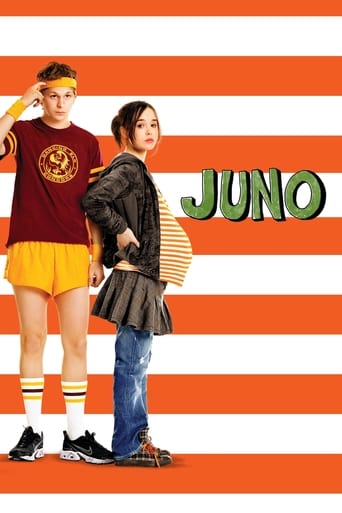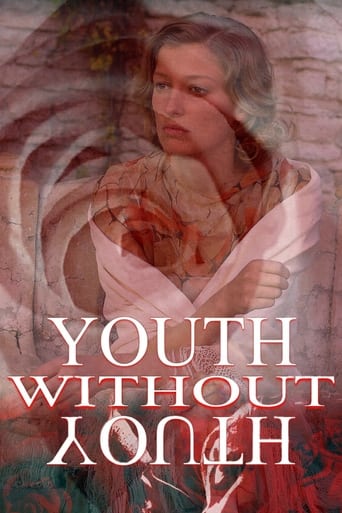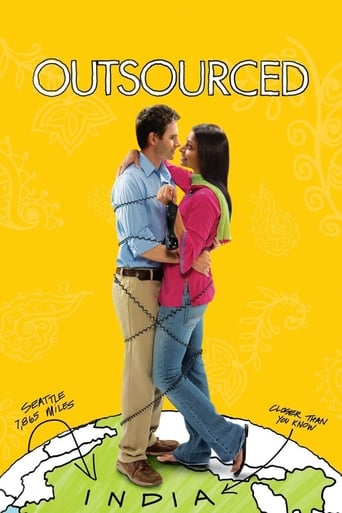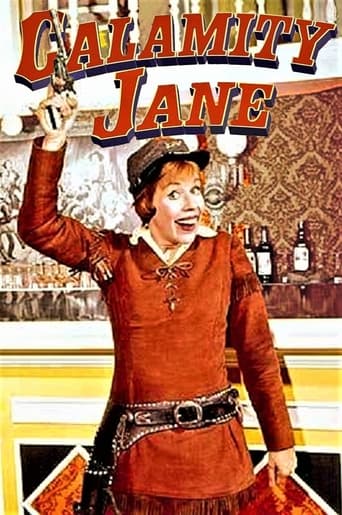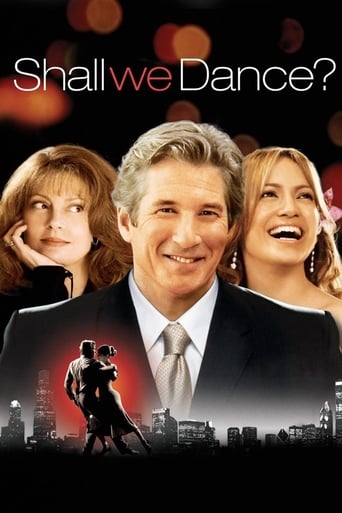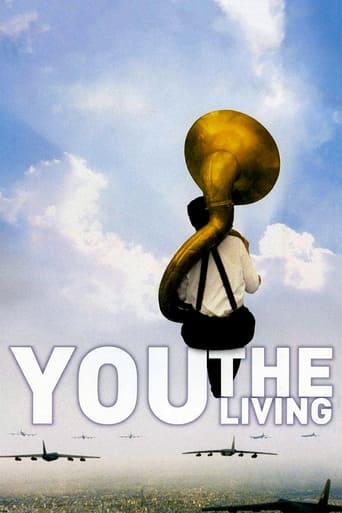
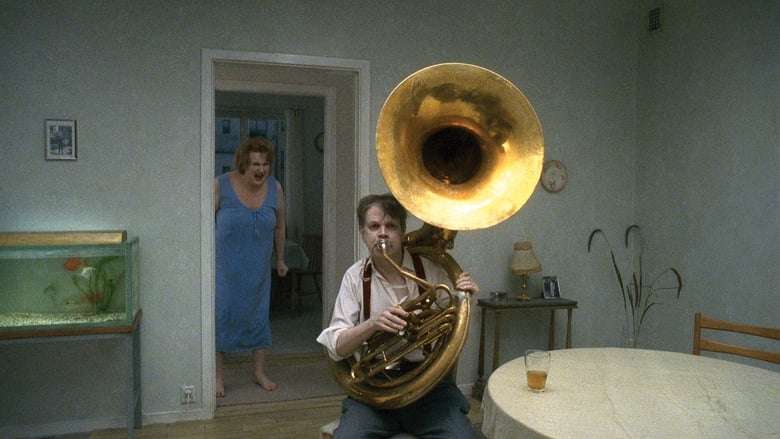
You, the Living (2009)
In the Swedish city of Lethe, people from different walks of life take part in a series of short, deadpan vignettes that rush past. Some are just seconds long, none longer than a couple of minutes. A young woman (Jessica Lundberg) remembers a fantasy honeymoon with a rock guitarist. A man awakes from a dream about bomber planes. A businessman boasts about success while being robbed by a pickpocket and so on. The absurdist collection is accompanied by Dixieland jazz and similar music.
Watch Trailer
Cast



Similar titles
Reviews
This movie is the proof that the world is becoming a sick and dumb place
Memorable, crazy movie
Highly Overrated But Still Good
Admirable film.
You, the Living (Sweden, 2007) captures every day life's sorrows, joys, and regrets through the world's best medicine, humor. Roy Anderrsson, the director and writer of You, the Living, uses off beat sarcasm similar to that of Monty Python to portray short clips of unglamorous people from all different walks of life. Although many of the characters appear to be in the dumps, the whimsical comments and random actions in the background make for a somewhat lighthearted film.Within You, the Living there is no clear plot line nor do all of the characters have an actual name but they all a story to tell. The film opens with a frumpy middle-aged man snoring and fast asleep on a sofa. In the background you can see that there is a fake skyline out the window, which added a humorous touch on the set. The man suddenly awakes and states: "I just had a nightmare". This first scene set the anticipation for odd and out of place interactions.In addition to the snoring man on the sofa there are several other absurd and rather interesting characters. For example, there's the tuba player that announces he lost his retirement money while having unexciting sex with his wife, the teacher that cries in front her class because her husband called her a hag, the man that gets invited to a dinner party and sent to an electric chair shortly after etc. Collected together these characters create a theme of the common man's life and how dismal yet silly it can be.A way that these strange characters escape their dismal lives and find deeper meaning is through music. Some of the characters are members of a Louisiana music band that plays at rather strange venues. Each individual member of the band is given their own independent life snapshot; showing them practicing their music while having rather boring lives. Though their lives are unexciting they're band is a offbeat and quirky. For example, the band plays upbeat New Orleans music at a funeral, which at first appears inappropriate. That is until a woman accompanying the band sings a song about living in a land without tears or sorrow. The song combined with the place and circumstance added to the nature of the film as I found it comedic, touching and somber.Intertwined with music there is a theme of desiring to be loved and feeling unloved. Anna, a hopeless purple boot-wearing romantic, desires to be with, Micke Larsson, the lead singer and guitarist of a punk rock band. Anxious to see him, she practices telling him that she thinks, "he sounded great" at the show, she wishes he called her, and ultimately that she loves him. None of these words are actually spoken to him, which reveals her desperate nature and desire to be loved by him. Towards the end of the film, Anna describes a dream in which she marries Micke. The dream has Micke and Anna post wedding relaxing in a moving house. The house comes to a standstill in front of a crowd of random people that congratulate them on their marriage. The scene was rather bittersweet because the dream was whimsical and charming but the reality is that Anna will always long for his love.Though all the characters faced quite different hardships one consistency was having random people with blank stares scattered throughout the majority of scenes. Literally almost every scene had a random nurse or bystander in the background that would stare directly at the camera as someone talked. At first I thought the stares were just to add comedic effect but it also brought attention to those in the background. This effect made me wonder who the main subject was of each scene. Additionally, it showed that extras could have an impact on the scene greatly when in a position to stick out.The director, Roy Andersson, used many camera techniques to make the scene comical yet bleak. For example, he used dark colored lens to show the baseness of the plain character's lives. In contrast with these colors he had fake painted skylines that made it hard to take the scene seriously. The majority of Andersson's scenes were used with a tripod and showed the entirety of the scene. This made me feel as though I was an additional bystander observing these people's lives whether it was from across a street, through a door, or against a wall.Overall the film was quite absurd and mildly entertaining in some scenes. I would recommend this film to anyone that like's Monty Python's humor and doesn't need an in depth story line to be entertained.
You, The Living (Du Levande) is a film compiled of a series of vignettes directed by Swedish film maker, Roy Andersson. The stories address human nature – the propensity to see what is wrong instead of what is good; the inclination to egoism and self-obsession; the tendency to dwell on dreams and fantasies, rather than living a life based in reality. It begins with the following quotation, belonging to the poet, Goethe, according to Wikipedia's article regarding the film: 'Therefore rejoice, you, the living, in your lovely warm bed, until Lethe's cold wave wets your fleeing foot" (http://en.wikipedia.org/wiki/You,_the_Living). Lethe (again, according to Wikipedia), is one of the five rivers in Hades and is the "river of unmindfulness" (http://en.wikipedia.org/wiki/Lethe). The poem, and, consequently, the message of the film is that one should enjoy life while they're living, because death is sure to come.The stories Andersson tells are interesting. The characters are distinct. The dialogues and monologues are pithy and poetic. Most scenes are shot in natural light – if it can be called light; the setting is Sweden over a period of perhaps one week, when there is persistent cloud cover only interrupted by a raging storm. The literal darkness of the film is reflected in the attitudes the characters possess and the humorous situations that emerge. The humor is sharp and funereal as one would expect. The sets themselves are bleak, dingy, and gray, as is the clothing – with the one exception of the fuchsia boots worn by Anna, the one character who does attempt to seize opportunity and make her dreams a reality. Only when the sun finally emerges do we see color. The pervasive solemnity is juxtaposed with the happy sounds produced by the "Louisiana Brass Band." The points Andersson tries to make are clear, perhaps too clear. Our society values property over human life; taking business too seriously can quite literally kill you; it's pointless to waste your time and energy in a career that brings you unhappiness; feelings of isolation can obviously not be solved by pushing people away and drowning your sadness in alcohol; it's important to take time to make music. These points are all nicely illustrated. These stories, however, don't have the poignancy, the emotional impact I believe Andersson attempted to create and I had hoped to experience. Or, perhaps, that was not his intention. Because the stories are short stories, we spend too little time with the characters to become emotionally attached; their sadness, their self-pity, their complaints seem annoying, and the characters are largely unsympathetic as a result. This might have been Andersson's portrayal of how those outside us perceive our internal struggles.As I stated earlier, Andersson's film attempts to convey certain lessons. The preach-y undertones make this film at times difficult to enjoy; does anyone enjoy being told how to live? I think this is most clearly illustrated by the man who describes his dream of a family gathering with complete strangers; attempting to lighten the mood of the cantankerous bunch, he tries the tablecloth trick, which ends in a total disaster. The dishes fall onto the floor with the cloth, and on the surface of the long table are two designs, which I perceived to be the symbol of the Nazi Party. He is taken to court, where he is indicted for the gross neglect of property. One member of the party which he attended repeatedly berates him for having broken a casserole dish that had belonged to her great, great-grandmother. The suggested sentence is either life in prison or death. So there are three lessons packed into one scene: as a culture, we sweep our ugliness under the rug; we value tradition and glorify the past too greatly; we value possessions over people. The way in which these ideas are translated to the screen is imaginative and certainly comedic, but the intention to edify is very obvious and sometimes distracting.The characters are not entirely developed. We know little of their history and a lot about their sorrows. This is not conducive to a sympathetic movie audience. I often found myself waiting for one character or another to stop speaking because it was simply to irritating to listen. I wish the director had dedicated more time to establishing character plots and personalities.On the whole, I would not enthusiastically recommend this film. The script was good, the music excellent, the stories were mostly interesting. I developed very little attachment or sympathy for the characters; the setting was oppressive; and I don't tend to like movies that try to persuade me. If you like dark humor with sermonic undertones, this film is for you.
This film is an exquisite exploration of the human condition. What makes us human and holds us all together is sometimes more important than the surrounding events that are taking place. This is the main premise for You, the Living, as we enter a peculiar world filled with grief, loneliness, and sadness. The film is set up as a staged performance. The camera rarely moves and the subjects are almost always sitting completely still and simply narrating or doing some other seemingly out of place action. When I first watched this movie, the first few scenes were something that I had never experienced before in my movie going past. I tried to figure out the genre of the film, but as more and more scenes went by the purpose of the scene construction became more and more clear. We enter into a dream like state. Everything in the movie when picked apart individually seems to be rather normal. But we still get a sense that there is just something off about the whole film. The timing is a bit awkward. People's interactions with one another are just a bit off. People's actions are out of place. What then can we say is the driving force behind the movie? There isn't a central plot to hold on to; we skip around to different characters that all end up in some way having interactions with each other. This strengthens the sense of dreaminess about the film as frequently you might have several seemingly disconnected dreams in a night but there is one thing that ties them all together. The construction of this film, when viewed in this way is extraordinary. You need the whole film to know what is going on. The film plot and story are not being acted out by actors, but rather the editing and the scenes themselves. You can look at just about any scene individually and write the movie off as almost being completely insane. A long shot of a man playing a tuba? A long hall with people standing on chairs and singing? People shopping for carpet to only have the clerk break down and pour out his heart about his marriage? These are all things weave together to address what we all feel as people. What we dream about, good, bad, rewarding is captured by this film. For example, we have a middle eastern barber who shaves the head of an arrogant customer. Anyone who works in a customer service industry knows what it is like to deal with pushy customers all day and how good it would be to just to act out. Another example would be the carpet salesman who all of the sudden went on a long rant about his wife. Or the Prominent man of the community who was interrupted before an important speech by his son asking for money. What about the old man who was sent to the electric chair because he broke his wife's dishes? These things when paired with the dreamy filming of the film make you question that perhaps the events that take place are simply internal anxieties that manifest themselves in the world. Perhaps that is what Andersson is saying about the human condition. Maybe our deepest anxiety is that we are truthful with one another and, in the words of the characters in the film, "nobody understands." Overall, this is a very strong film. It is a film that is unique from any other film that I have seen previously. As you watch you are memorized by the oddity that each scene takes on. Previous film techniques are almost forgotten. We have very little movement, almost no action, and the camera remains still throughout. On top of that the plot doesn't exist. Instead we are left with small episodes that offer little to no resolution of the problems they present. In each scene only the main character of interest truly "acts." The rest of the people present simply have little to no reaction to what is going on with that character. As such this is a film about lonely people who are desperately trying to seek out and connect with others. Some people will not like this movie. People looking for a typical Hollywood experience should stay far away from this film. However, if you go into the film with an open mind and stick with the film to truly find out what the film is about it is an absolute delight. It is quirky, witty, funny, and sad. Most importantly it reminded me of just how versatile film as an art form truly is. I would say that it is probably the most memorable and inspiring movies that I have seen.
**This may contain spoilers**Roy Andersson presents viewers with a film of unconventional content. Lacking the traditional plot and list of main characters, You, the Living is a commentary on life's ups, downs, success and struggles as told through 50 some-odd "mini stories". Each scene, while simplistic and short, speaks to a different aspect of human nature. Each scene is simple in part because a single, static camera angle is used. Every scene in You, the Living uses a straight on camera angle. This single camera angle focuses audience's right into the heart of the scene. There is no jerking or nauseating camera movement to be distracted by. The static camera angle also prevents from the audience seeing any close ups of the actors. This makes the whole film seem somewhat distant and makes the characters hard to become emotionally attached to. Furthermore, each scene is adorned with simple props. Only what is necessary to the message of the scene is incorporated. With that said, Andersson also uses the scenery and props in order to bring some continuity to the film. For example, the same amateur band is seen playing in the background during several scenes and the same bar is used as a location. Lastly, almost every scene uses the same, bright, artificial lighting. The lighting has a tendency to wash out the colors and make the film have a uniform, muted color palate. Although You, the Living commentates on many different aspects of life and human nature, there seem to be two major unifying themes in the film. The first one, life goes on, is presented right from the start of the film. Mia, a "miserable wench on a bench" wails that no one understands her. While she lingers on the idea that she was happy yesterday but is not today, the man with her points out that that was yesterday, in the past. His advice to her invokes the importance of being present in our lives here and today. Similarly, later on the film, audiences are prompted to remember that tomorrow is another day and to try and recall good memories when life gets tough. The second unifying theme is to be kind to everyone you met. You never know when someone has been fighting with their loved ones, dealing with complex emotions or just hasn't had anything go right for them that day. Although our interactions with strangers are just a fraction of our days and lives, how we conduct ourselves in the presence of that person can have a huge impact on their day and life. With that said, You, the Living reminds us to live in comradeship with our fellow human beings. What I particularly enjoyed about this film was the little bits of subtle humor mixed in. The messages of each scene are quiet serious and deep but have little elements which make it funny. For example, the large and "biker tough" couple in one of the opening scenes have a tiny, little, fluffy dog which contradicts the "biker tough" image portrayed otherwise. In another scene, when a man is being unjustly punished by death with the electric chair for breaking 200 year old china, the "victims" are watching the execution and enjoying buckets of popcorn. Only a keen and observant eye will pick up on the subtle humor of the popcorn. I believe Andersson was using these sprinklings of humor to portray two ideas to audiences. The first is to really pay attention. By really focusing and paying attention in life you will pick up on so much more and get more enjoyment out of life. Secondly, the little bits of humor remind audiences not to take life too seriously and to find humor in every situation. In all I really enjoyed Roy Andersson's You, the Living. I believe the film would have benefited from cutting out a few scenes in order to shorten it and be able to keep audiences engaged more. By the last 20 minutes of the movie I was getting tired of the individual scenes and somewhat randomness of the film. While I really enjoyed this film, I believe it takes two or three sittings to really get all of messages and ideas Andersson is trying to portray. It takes some time to get used to the randomness of individual scenes and to get a sense of his style and overall themes. If I knew my friend was patient and a critical and reflective thinker than I would definitely recommend this film. I would, though, have to keep in mind the style of the film and the personality of the friend when considering a recommendation.




